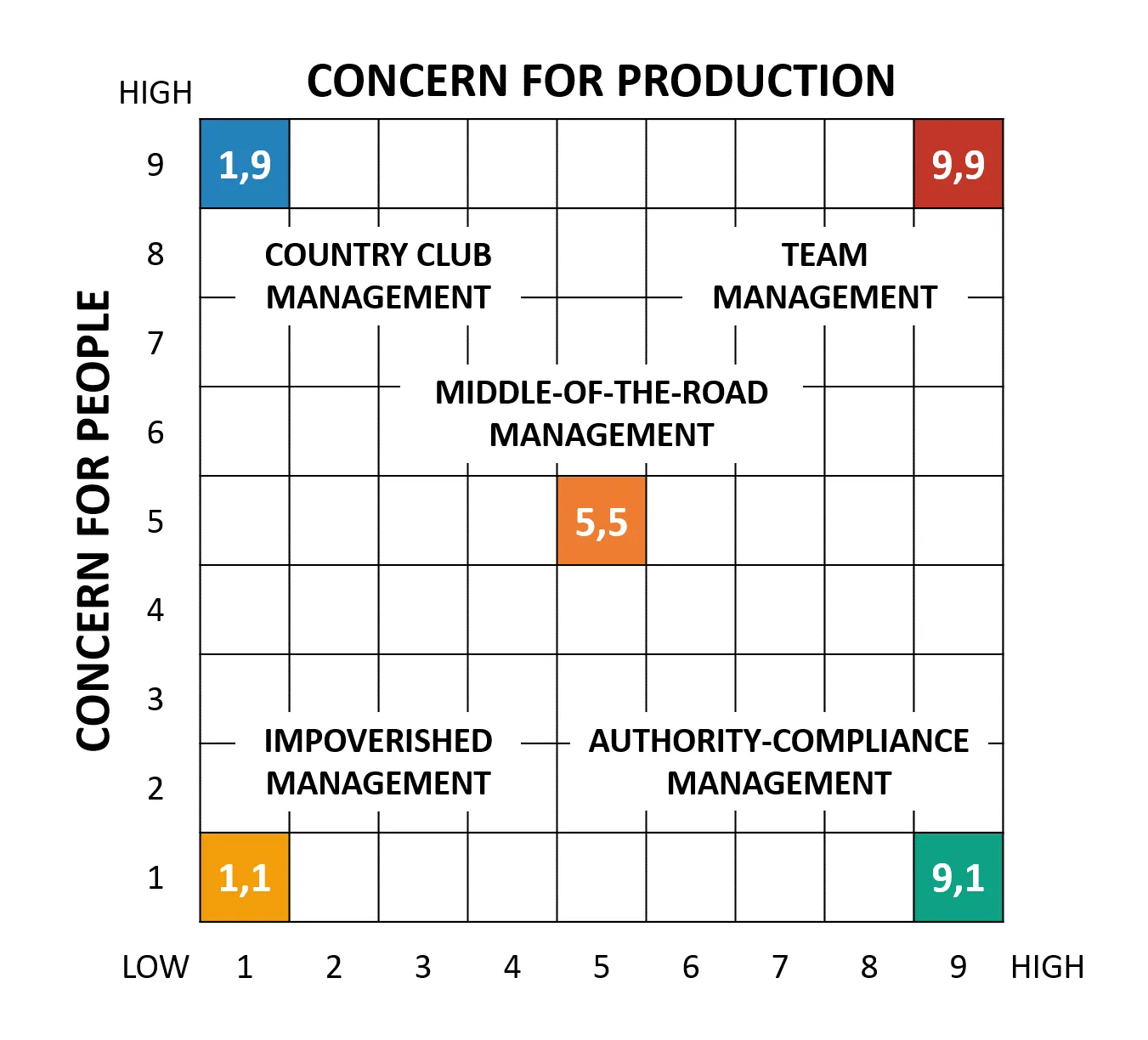The treatment of task orientation & people orientation as two independent dimensions was a major step in leadership studies. Many of the leadership studies conducted in the 1950s at the University of Michigan & the Ohio State University focused on these two dimensions.
Even though these two factors are not the only important management behaviours, concern for both the task & the people must been shown at some reasonable level.
Blake & Mouton Managerial Grid
Blake and Mouton state that there is also a third axis: Motivation – measured from negative (driven by fear) to positive (driven by desire).Inspired by these findings, Robert Blake & Jane Mouton from the University of Texas proposed a two-dimensional Managerial Grid based on a manager’s concern for production (task-oriented) & concern for people (relationship-oriented). Each axis on the grid consists of a nine-point scale with 1 meaning a low concern & 9 a high concern. Depending on a manager’s score on each of the two axis, you can assign different types of management styles to managers.

Blake & Mouton Managerial Grid
Concern for Production (Task-Oriented)
A concern for production means that managers direct subordinates towards goals. Managers with this style typically give instructions, spend time planning, emphasize deadlines & provide explicit schedules of work acitivities. They simply want to get the job done.
Concern for People (Relationship-Oriented)
A concern for people means that managers are mindful of subordinates, respect their ideas & feelings, establish mutual trust. These managers are friendly, provide open communication, develop teamwork, & are oriented toward their subordinates’ welfare.
Correspondingly, the 5 leadership styles are:
- Impoverished Management
- Task management
- Country Club Management
- Middle-of-the-Road Management
- Team Management
Impoverished Management (1,1)
Managers that score low on concern for production & low on concern for people are labelled as having an Impoverished Management style or Indifferent Management style. They exert minimum effort to get required work done & to maintain interpersonal relationships. Managers with this approach are low on both the dimensions & exercise minimum effort to get the work done from subordinates.
The motives for this type of managerial behaviour can differ. The main concern for Impoverished Managers is often to not be held responsible for mistakes. The leader has low concern for employee satisfaction & work deadlines & as a result disharmony & disorganization prevail within the organization. The leaders are termed ineffective wherein their action is merely aimed at preserving job & seniority.
Task management (9,1)
This managerial style is also called Authority-Compliance Management or Produce-or-Perish style. Here, leaders are more concerned about production & have less concern for people. These type of managers usually believe that subordinates’ needs are relatively unimportant. Efficiency in operations, however, should be the dominant orientation.
The leader believes that efficiency can result only through proper organization of work systems & through elimination of people wherever possible. Such a style can definitely increase the output of organization in short run but due to the strict policies & procedures, high labour turnover is inevitable.
This style is largely based on McGregor’s Theory X that states that employees generally have little ambition, avoid responsibilities, & are mostly extrinsically motivated.The employees’ needs are not taken care of & they are simply a means to an end. To boost performance, managers try to make subordinates comply by using tangible rewards such as monetary bonuses. Managers may even use their coercive powers to punish subordinates if targets are not being met.
Middle-of-the-Road Management (5,5)
Managers that score medium on concern for production & medium on concern for people have a Middle-of-the-Road Management style. They attempt to balance between an organization’s performance targets & the needs of employees.
This is a compromising style wherein the leader tries to maintain a balance between goals of company & the needs of people. The leader does not push the boundaries of achievement resulting in average performance for organization. The major downside of this approach is the danger that neither aspect (concern for production & concern for people) is delivered to satisfactorily levels.
Country Club Management (1,9)
Managers that score low on concern for production & high on concern for people are considered to have a Country Club Management style.
This is a collegial style characterized by low task & high people orientation. Here, the manager gives thoughtful attention to the needs of people thus providing them with a friendly & comfortable environment. They pay a lot of attention to the security, well-being & harmony of their subordinates. They firmly belief that being accomodating to the needs of subordinates will ultimately increase performance, as everybody will be happy & contented.
Consequently, the primary emphasis of Country Club managers is given to people rather than to work outputs. Therefore, the resulting work atmosphere is usually quite friendly & easy-going, but not very productive. Individual subordinates that are more task-focused might experience this management style quite frustrating.
Team Management (9,9)
If managers score high on concern for production & high on concern for people, they can be labelled as having a Team Management style. Characterized by high people & task focus, the style is based on the theory Y of McGregor & has been termed as most effective style according to Blake & Mouton. The leader feels that empowerment, commitment, trust, & respect are the key elements in creating a team atmosphere which will automatically result in high employee satisfaction & production.
This style is often considered to be the most effective & is recommended for managers because organization members work together to accomplish tasks & maintain good relationships. This approach relies heavily on making subordinates feel that they are constructive parts of the organization by encouraging teamwork & commitment, involving them in decision-making, & showing respect & mutual trust.
This management style is largely in-line with McGregor’s Theory Y that states that employees are intrinsically motivated, enjoy their job, & want to work to better themselves without a direct reward in return. According to multiple subsequent research from Blake & Mouton, Team Management forms the best basis for exercising sound leadership.
Further management styles
Apart from these 5 well-known management styles, more management styles can be crafted with the aid of Blake & Mouton’s Managerial Grid.
An additional approach refers to a manager who swings back & forth between the Country Club Management style & the Authority-Compliance Management style.
A manager with Paternalism-Maternalism Management style is seen as a kind of caring dictator who, as long as you do as you are instructed, will treat you well. Failure to comply, however, is likely to lead to punishment or exclusion from the group.
Furthermore, there is the Opportunistic Management style, which can be described as exploit & manipulate. These managers do not have a fixed location on the grid & use different management styles depending on their interpretation of what is likely to result in the maximum personal benefit.
This way of behaving comes close to management approaches from Situational Leadership Theory & Contingency Theory, such as Hersey & Blanchard’s Situational Leadership Model & Fiedler’s Contingency Model. These research streams assume that leaders or managers should adapt their style based on the circumstances, i.e. type of follower &/or external factors.




